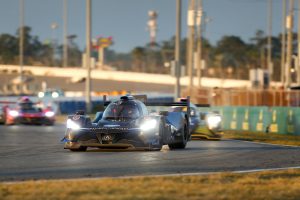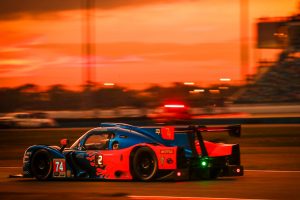New Format for 2021 Makes its First Appearance on Friday
By Mark Robinson
SEBRING, Fla. – The IMSA WeatherTech SportsCar Championship will unveil its exciting new qualifying format Friday at Sebring International Raceway.
With championship points now awarded for qualifying, the precursor session for the Mobil 1 Twelve Hours of Sebring Presented by Advance Auto Parts takes on more importance in addition to setting the starting grid for Saturday’s race.
The new format will add a layer of excitement by offering two qualifying segments for the GT Daytona (GTD) class. Each segment is 15 minutes in length. The first will see a Silver- or Bronze-rated driver in each GTD car vying for race starting position decided by the best timed laps, with the fastest qualifier earning the Motul Pole Award. The second segment mandates a driver change, likely to a Platinum- or Gold-rated professional, to determine the team and driver qualifying points – again set by the fastest laps turned.
Zacharie Robichon, co-driver of the No. 9 Pfaff Motorsports Porsche 911 GT3R along with Laurens Vanthoor and Lars Kern this weekend, said qualifying has been a hot topic of conversation among the drivers and team.
“We’ve been exchanging lots of emails about it,” Robichon said. “It’s certainly going to be different. I think the way we prioritize time during practice will be a little less straightforward than it has been in the past with the two separate qualifying sessions. I think what you’ll see is perhaps a differentiation on how you approach it depending on which race it is. Where the focus will stand over who gets the qualifying stint may change on the individual track and the characteristics.”
The GTD driver who participates in the first qualifying segment must start the race. Teams have the option to change tires between segments but must start the race on the Michelins used in the first segment.
Qualifying for the other WeatherTech Championship classes – Daytona Prototype international (DPi), Le Mans Prototype 2 (LMP2), Le Mans Prototype 3 (LMP3) and GT Le Mans (GTLM) – will each remain a single segment that decides both points and race starting position. The pole winner in every class earns 35 points, with 32 for second fastest, 30 for third and downward from there. With 10 races scheduled for DPi, GTLM and GTD, that means the maximum points equivalent of a race win is available for the taking in qualifying throughout 2021.
“I think it definitely adds a strategy point,” Robichon said. “You can always make up places on the racetrack but you can’t make up points, so I think that’s something that you have to keep in mind.”
This is the first weekend that the new format will be conducted. Qualifying points and race starting position for the Rolex 24 At Daytona in January were determined by results of the Motul Pole Award 100 qualifying race.
Mobil 1 Twelve Hours of Sebring qualifying begins at 11:15 a.m. ET Friday and streams live on IMSA.com. The 69th edition of the famed 12-hour race begins at 10:10 a.m. Saturday. NBCSN has live coverage from 10 a.m.-noon and 7-10:30 p.m., with a shift to the NBC Sports App and NBCSports.com from noon-7 p.m. The entire telecast is available on TrackPass on NBC Sports Gold. Find IMSA Radio’s race coverage on IMSA.com, RadioLeMans.com and SiriusXM Radio (Sirius channel 216, XM 392, Internet 992).
Wayne Taylor Racing Takes Aim at Florida Double
Just because they won the season opener, the drivers and crew at Wayne Taylor Racing aren’t resting on any laurels. The No. 10 Konica Minolta Acura ARX-05 spent a couple days recently testing at Sebring International Raceway in a bid to earn the Florida double of winning the Rolex 24 and Mobil 1 Twelve Hours of Sebring to start the season.
 Filipe Albuquerque, who drove the nail-biting final laps to the checkered flag at Daytona International Speedway in January, said the Sebring test was a success.
Filipe Albuquerque, who drove the nail-biting final laps to the checkered flag at Daytona International Speedway in January, said the Sebring test was a success.
“We went through the checklist that we had to do,” Albuquerque said. “We were competitive in the way that we were happy with the car balance, but we need to wait for the competition to show their hand and see where we are compared to them.”
Ricky Taylor, the other full-season driver in the No. 10, said the test allowed WTR to zero in on ways to make the car stronger over the notoriously rough Sebring circuit. The Cadillac DPi cars are said to handle the Sebring bumps better than the Acuras, but Taylor said there are other areas where the Acura can make up for it.
“You always have to understand what your car does well and what it doesn’t do well,” Taylor said. “We’ve been able to exploit the areas where we’re really strong to a point, to where I feel like when we come to Sebring, we’re strong – even if we aren’t as good over the bumps.”
Speaking of coming to Sebring, WTR’s third driver Alexander Rossi has felt more like a Sebring resident than a guest recently. Between his fulltime job as an IndyCar driver for Andretti Autosport and his WeatherTech Championship endurance-race gig for WTR, the 2016 Indy 500 winner has logged plenty of time at the Central Florida track.
“I’ve spent a lot of days at Sebring,” Rossi said. “I should probably get a house here, the amount of time I’ve spent here the past couple months. It’s been busy but it’s great. I’ve been getting to drive a race car almost every week, which is good.”
The last prototype team to win the Rolex 24 and Sebring 12 Hours in the same season? Wayne Taylor Racing in 2017, with Ricky Taylor among the drivers.
No. 74 Riley Motorsports Looks to Bump toward another LMP3 Win
Like WTR, the drivers of the No. 74 Riley Motorsports Ligier JS P320 are looking to tack a Sebring victory onto a Daytona win, albeit in the new-for-2021 LMP3 class.
Australian driver Scott Andrews admitted it took time for the Daytona triumph to sink in.
 “It was like a little bit unreal for two or three weeks and then it finally sunk in,” he said. “It’s a really great achievement that we should all be really proud of. Now we just go with the same mentality at Sebring and cross our T’s and dot our I’s, and just make sure we do everything well. We’re confident we think we have a pretty good car heading in – we had a pretty successful test – so we’ll see.”
“It was like a little bit unreal for two or three weeks and then it finally sunk in,” he said. “It’s a really great achievement that we should all be really proud of. Now we just go with the same mentality at Sebring and cross our T’s and dot our I’s, and just make sure we do everything well. We’re confident we think we have a pretty good car heading in – we had a pretty successful test – so we’ll see.”
The biggest question for all the LMP3s heading into Daytona was reliability since none had ever gone the 24-hour distance before. The No. 74 responded with a near- perfect race, winning by three laps.
“We were all pleasantly surprised by the race at Daytona,” said Spencer Pigot, filling in as the endurance add-on again. “Going into the race, we were talking about whoever was going to have the fewest amount of issues and could spend the least amount of time back in the garage. As it turned out, we didn’t spend any time back in the garage and had a flawless race.
“Sebring is a different animal,” warned Pigot, who’s logged years of time on the track between Skip Barber racing, IndyCars and WeatherTech Championship prototypes. “The track’s a lot more bumpy and harsh on the car, so it will be interesting to see how the cars get on there.”
Gar Robinson, the under-30 Silver driver on the team, is making the transition from lower-downforce GT cars to prototypes this year. Sebring’s bumps and unevenness tend to force teams to increase the car’s ride height, which decreases the downforce generated. Robinson said the track provides a great lesson in his LMP3 learning curve.
“It’s been a lot,” Robinson admitted. “Downforce and stuff has been interesting for me to learn. Having to believe a car will do what it will actually do can be hard sometimes but we’re getting there, and just more seat time through these long races will get me better experience and quicker toward the end of the year.”
